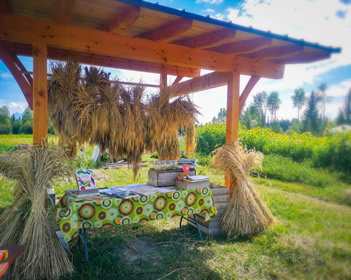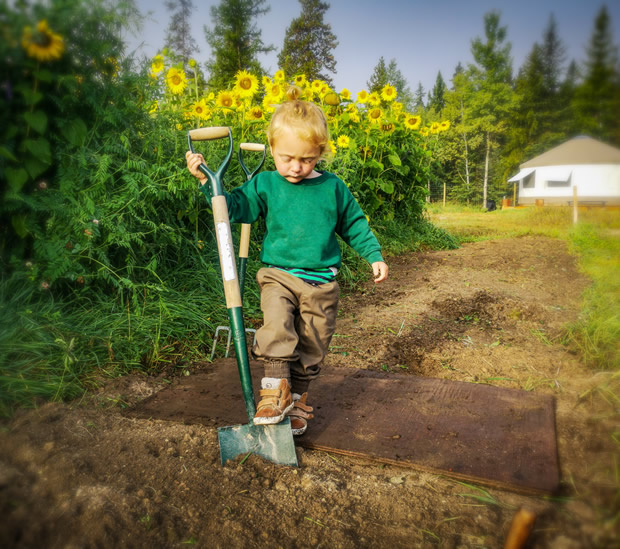GB Tours in B.C.
After our 8-month internship with Ecology Action in 2016, we established a GB R&D site in Kimberley, British Columbia (BC), Canada. A significant part of our approach to teaching GB has been to inspire people through tours. A picture paints a thousand words, but experiencing a living garden ecosystem reaches people on a whole deeper level! This season we began offering a monthly tour, designed to appeal to as many people as possible. We chose a recurring date, the last Saturday of the month; it is easy to remember, allows us to use a single flyer to promote every tour for the season, and contributes to more word-of-mouth attendance! (Our 2020 tours are the 2nd Saturday of May, June, July, August and September—growsustainability.org.) We advertise our tours as fun, educational, and open to all ages, with info about GB, some demonstration and skill building, Q&A, and more. Our community has a lot of young families, so to appeal to the family unit, we created a scavenger hunt for kids, a self-guided exercise for adolescents, and provide free tea, coffee and snacks. The tours run 10am-2pm. We start by introducing ourselves, followed by a brief history of John Jeavons and GB, and then participants can share a bit about themselves. Opening with dialogue and conversation breaks the ice and helps people settle into the experience. Next, we begin the tour of our mini-farm, guided by the 8 Principles of GROW BIOINTENSIVE, with demonstrations of GB techniques and opportunity for questions. We start with the first three principles of GB: Deep Soil Preparation, Intensive Planting and Composting. We demonstrate double-digging, emphasizing the importance of soil structure; demonstrate flatting techniques, showing an example of hexagonal spacing in a nearby bed; and briefly outline the recipe we use to build compost, emphasizing the importance of composting for long-term sustainability and growing soil in our beds. We set these "stations" close together so we can build on each one without traveling to other areas of the garden. Next, a short break to digest the sometimes-overwhelming quantity of "ah-ha!" moments and to offer refreshments. Then, we resume with Carbon Farming and Calorie Farming, taking the group further into the garden. We discuss qualities that define a carbon-and-calorie crop, and elaborate on why we grow 60% of our area in carbon crops, 30% in seven special root crops, and only 10% in vitamin and mineral crops. When designing our garden, we create areas that highlight certain tour subjects. For instance, we grew 15 varieties of barley this season in one area, which served as a great example of carbon farming and helped demonstrate research goals. We also planted garlic, leeks, potato and parsnip in one area, (4/7 special root crops) to demonstrate calorie farming and how these crops are calorie-efficient by area! Next we visit our quinoa bed to demonstrate and discuss three ways we practice Companion Planting: side by side, interplanting, and successively planting. Following Matt Drewno's research, we interplanted quinoa with vetch, a nitrogen-fixing legume, to great success! We proceed to a cover-cropped bed to explain the benefits of planting legumes and grains before a main season crop, and discuss using companions as "trap" plants (e.g., growing mustard to attract flea beetles & aphids). We travel to a seed-crop bed next, and discuss why we only use Open-Pollinated Seeds. This year we grew leeks, parsnips and lettuce to seed, offering a variety of flowering crops to explore. We emphasize the ability to locally acclimatize OP seeds, and how their genetic diversity provides an insurance policy to respond to climate change and increasing climate extremes. Finally, we travel to our new circular flower bed to talk about why a Whole-System Approach is critical to long-term sustainability, and we touch on the principle of embodied energy in our tools and materials. We also speak about including ourselves as a part of the garden ecosystem, not as a dominating force, but instead opening up and developing a garden intuition that comes with relaxed observation and integration.
So why do we offer these tours? It's about inspiration! We truly feel that leading by example, and offering people an opportunity to see and feel how magical and productive a GB garden can be will inspire people to want to learn more, tell a friend or family member, and perhaps even start a GB garden at home! We also hope tours will increase interest in our skill-building workshops. We start by inspiring visitors, then strive to empower them by teaching the skills needed to practice GB at home and then build success through a variety of workshops. Our goal is to inspire and empower as many people as possible; in our community, in British Columbia, and in Canada as a whole. We believe food localization and security are important considerations for the future, and that an achievable solution is to encourage as many people as possible to start backyard and community gardens using the easy to learn and truly sustainable GROW BIOINTENSIVE method, and to participate, as a community, in feeding each other from a place of abundance! We have the space, the time, and the resources, we just need to spark that inspiration and empower our community to take action!
Growing people If we're to grow the caring and appreciation of the natural world and a respect for the environment, we believe we can foster that in our children from a very young age! Getting our son Lincoln involved and participating in the every day tasks on our GB R&D site in BC Canada has had a profound impact on his understanding of nature. He's learning that there are many forms of life: insects, birds, and plants, and that they live above and below the soil in our garden ecosystem.
We're also hopeful he'll appreciate the benefits of double digging a GB bed, and he's already picking up tools and digging the earth along side us!
You're never too young (or old) to start double digging! top | Newsletter Home |Table of Contents| Archive
|



 We encourage questions throughout the tour, and much to our delight the tour often takes more than 2 hours to complete due to the high number of questions, elaborations and interaction throughout! Following the tour, we offer time for further Q & A, reflections, and an opportunity for more demonstrations. We've offered John's HTGMV for sale during tours and we're delighted that several people have picked up a copy before they leave!
We encourage questions throughout the tour, and much to our delight the tour often takes more than 2 hours to complete due to the high number of questions, elaborations and interaction throughout! Following the tour, we offer time for further Q & A, reflections, and an opportunity for more demonstrations. We've offered John's HTGMV for sale during tours and we're delighted that several people have picked up a copy before they leave!

